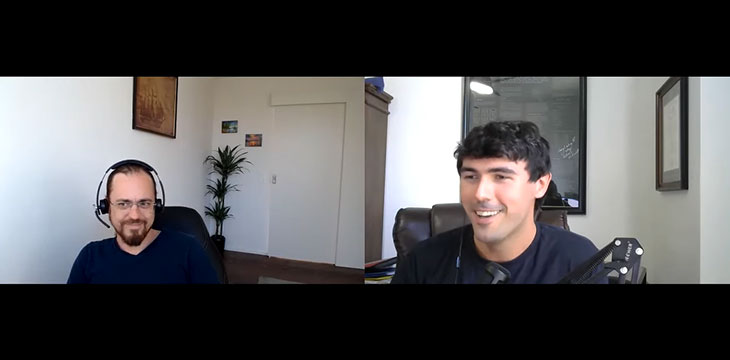|
Getting your Trinity Audio player ready...
|
Steve Shadders sat down with Connor Murray of Murray Distributed Technologies and discussed his background and journey into BSV, the latest BSV node software release (v. 1.0.9), the block reorg attack attempts that took place in the summer of 2021, and block reward mining in general.
How BSV found Steve
Shadders is not new to mining, and his prior experiences working on pool software and blockchain libraries prepared him to spearhead the Bitcoin SV infrastructure team.
“In my earlier days, I wrote pool software and contributed a lot to Bitcoin. I somehow ran into Craig on the internet, and he learned a bit more about my history. I was living in Australia at the time, and I was doing some work for nChain and it wasn’t too long before I met some of the nChain people on a business trip to Japan. Shortly after that, the discussion started around me moving to London,” Shadders said.
“I wasn’t meant to move over there to take the job that I’m kind of doing [now], it was a different role, but I sort of found myself in a technical strategy and leadership role fairly quickly which certainly pushed me out of my comfort zone. It was only about 2-3 months after I moved to London that it became apparent that we had a hash war upcoming, [and] my skill set was a natural fit to lead the formation of the Bitcoin SV team—that’s roughly the story [of how I found BSV and got to where I am today],” he said.
Murray and Shadders went on and discussed the latest release from the infrastructure team, node software 1.0.9 and why many of the features within that latest release were created.
Block reorg attacks and Node Software 1.0.9
A lot of the new features added to the latest version of the node software improve the security of the Bitcoin SV network. Shadders told Murray that the implementations are meant to mitigate the effects of an attack on the BSV network and reduce the probability that an attacker will be successful. Nearly all of the newly added features come in response to the attempted block reorg attacks that we saw take place on the BSV network between June and August 2021.
“I guess the double-spend features of the new release are targeting the recent events that happened on [Bitcoin] SV with the reorgs. There’s a lot of misconception that the reorgs didn’t contain double-spend transactions when my understanding is that they contained millions of dollars worth of double-spends. And my second question, is this proof that selfish mining is a real thing? Everyone is calling this a selfish mining attack,” Murray asked.
To which Shadders replied, “I wouldn’t call it a selfish mining attack because the goal of selfish mining is to manipulate difficulty and the proportion of blocks found by different miners in order to advantage the selfish miner. I don’t think that’s what was happening here. Another theory was that the attacks were coming from somebody trying to create a media incident to cause reputational harm, but it seems like a lot of money to spend to do that.”
“The cost of the attack is the hash power cost to produce these blocks, the first couple of times the attacker tried this, they were short chains, four or five blocks. And that’s not a significant cost. But then the attacker came back later and had to mine significantly longer chains because exchanges had moved their confirmation limits up, so we are talking about chains of blocks that were 80+, so the hashing cost of those is $100,000 or more and that seems like a lot of money to spend for a media stunt.”
“Once that long chain of blocks got orphaned, they tried again straight away and failed a second time, and after that, they haven’t tried it again; this suggests to me that the very substantial economic loss that they suffered was enough to make them think twice about it. Maybe this is something that had to happen on Bitcoin once so that people could see what the potential outcome was in order to make future attackers think twice about it,” Shadders explained.
Other key insights
Throughout the conversation, Shadders provided several insights that will be helpful to anyone interested in blockchain technology or BSV. He explained implementations that allow nodes to efficiently and quickly communicate with one another to reach finality.
“Bitcoin SV, when configured properly, is a small-world network that can give you finality in a very short space of time, within two network hops.”
Shadders also talked about what end-users or software developers should do if they are having trouble with the soft-caps that many miners have in place.
“All it really takes is a conversation with the miners which is much more effective than a tweet,” he said.
Lastly, he discussed the approach individuals and enterprises should take when it comes to creating solutions on the BSV blockchain.
“I like to say Bitcoin was designed to solve real problems, not non-problems and made-up problems. It’s really easy to describe a scenario where you think Bitcoin might not work as you would want it to be, but you always need to ask yourself, would this realistically happen in the real world and what would the normal mitigation be if you were doing this with cash.”
To learn more about Bitcoin SV Nodes and the Bitcoin Network, you can watch the full conversation between Shadders and Murray on the Murray Distributed Technologies YouTube Channel.
Watch: CoinGeek New York presentation, BSV Technical Update

 12-17-2025
12-17-2025 




